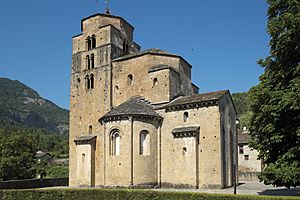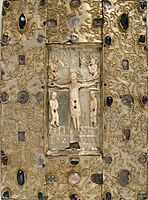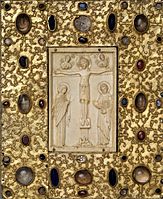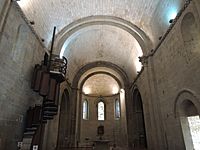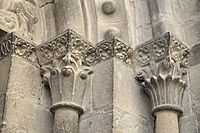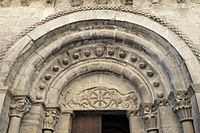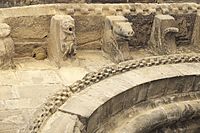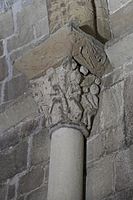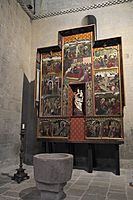Santa María de Santa Cruz de la Serós facts for kids
Santa María de Santa Cruz de la Serós is a very old Benedictine nunnery (a place where nuns live) in Spain. It's located about ten miles from Jaca, in a small village called Santa Cruz de la Serós. The village even got its name from the nunnery! Another old church, San Caprasio, built around 1020-1030, is also in the same village.
A Royal Family's Monastery
In the 11th century, this nunnery was like a special "family monastery" for the royal family of Aragon. Women from the royal family lived there as nuns and even led the monastery. Other family members who didn't live there still supported it with money and gifts.
We don't know exactly when Santa María was built. The first time it's mentioned in a written record is in 1070. In that document, Sancha de Aibar, who was the mother of King Ramiro I, gave some land to Ramiro I's daughter, also named Sancha. The rule was that when the younger Sancha died, the land would go to the nuns of Santa María.
Even though this is the first mention, the nunnery seemed to have been around for a while. It already had an abbess (the head nun) named Menosa and a church building. The document was even written "in the atrium of Santa María, before the abbess Lady Menosa."
In her will from 1095, the younger Sancha said her gift should go to "the workshop of the church for Santa María." Ramiro I had two other daughters, Teresa and Urraca. Teresa never married, and Urraca might have married a count. Both of them also gave gifts to Santa María before they became nuns there. Urraca probably joined the nunnery around 1070.
King Ramiro I's daughter-in-law, Felicia, who was married to King Sancho Ramírez, gave a special book called an evangelary to the nunnery. An evangelary is a book containing parts of the Gospels from the Bible. This book is now lost, but two beautiful silver-gilt covers, which might have been its book covers, still exist. These covers have some Byzantine ivories (small carvings made from ivory). One of the covers even has Felicia's name on it! They are now kept in the Metropolitan Museum of Art in New York. Both of these covers might have once belonged to Santa María.
Church Architecture
The nuns' church was being built in the late 11th century. It's one of the first buildings in Aragon made in the Romanesque style. This style is known for its thick walls, round arches, and strong, simple shapes.
The church is the only building from the old nunnery that is still standing. It has a Latin cross shape, which means it looks like a cross from above. The outside walls are made of carefully cut stones called ashlar masonry. Inside, you can see beautiful carved capitals (the tops of columns) and fancy mouldings (decorative strips).
The main part of the church, called the nave, has a barrel-vaulted ceiling. This means the ceiling is shaped like a half-cylinder. At the end of the nave is a semicircular apse. The south arm of the transept (the part of the church that crosses the nave) has a tall tower with a dome on squinches (arches that help support a dome on a square base). The church looks very solid and strong. Many parts of the building still have traces of polychrome, meaning they were once painted in bright colors!
Above the main entrance, there's a carved stone panel called a tympanum. It shows a special symbol called a chrismon and two lions. These lions look a lot like the ones on the tympanum of the cathedral of Jaca, which was an important city for the Aragon kings.
There's also a very interesting "secret" room in the church! It's an octagonal (eight-sided) chamber located above the crossing (where the nave and transept meet). It has a ribbed dome-shaped ceiling. You can only get to this room by climbing a steep, hidden stairway inside the thick south wall of the nave. The stairs start from a small door high up in the wall. This secret room might have been where the abbess lived, or perhaps a safe place for the nuns to hide if there was danger. One of the carved stone supports in this room was made by the same artist who carved the tomb of Ramiro I's daughter Sancha.
In 1490, a large reredos (a decorated screen behind the altar) was added near the holy water font. It had a beautiful alabaster sculpture of the Virgin Mary. Some carved capitals from the old cloisters (covered walkways) that are now gone were also moved to this area.
See also
 In Spanish: Iglesia de Santa María (Santa Cruz de la Serós) para niños
In Spanish: Iglesia de Santa María (Santa Cruz de la Serós) para niños


